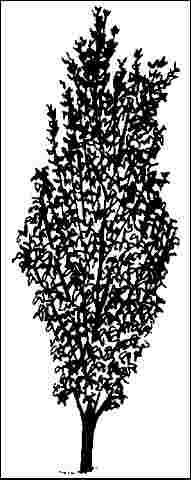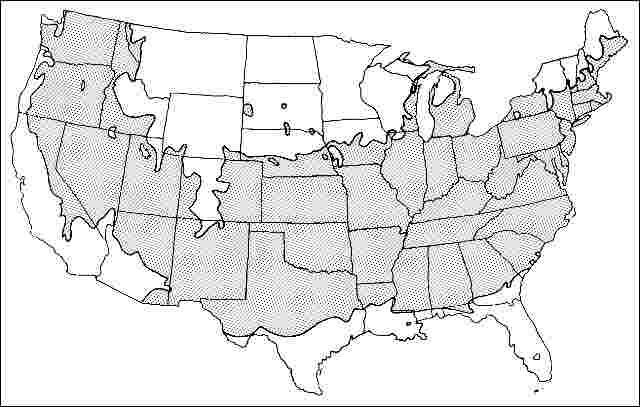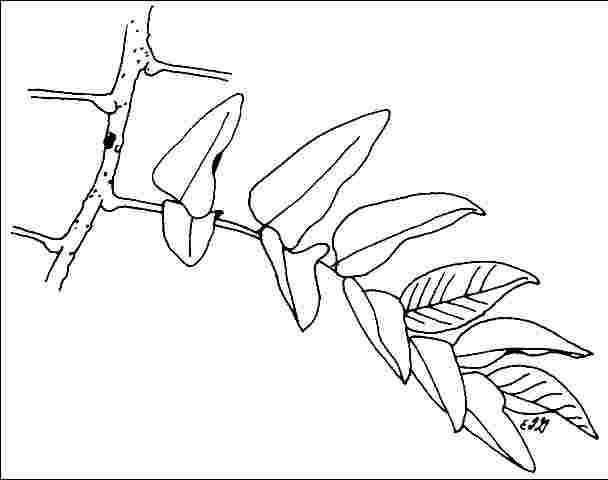Introduction
This cultivar of pagoda tree probably has a height of about 40 feet and spread of 15 to 20 feet, forming a fine-textured, upright canopy. It has a rapid growth rate and tolerates polluted city conditions, heat, and drought. The tree prefers a sunny, open location on any light soil. The very showy, greenish-white to yellow flowers are produced in mid- to late-summer and provide an airy feel to the tree for several weeks. A yellow dye can be made by boiling the dried flowers and buds in water. The young green twigs turn a dark grey with age. It has been reported that the species must be about 10-years-old to bloom, but the cultivar 'Regent' apparently blooms at an earlier age.

Credit: UF/IFAS
General Information
Scientific name: Styphnolobium japonicum
Pronunciation: stiff-no-lobe-ee-um juh-PAWN-ih-kum
Common name(s): Columnar scholar tree, columnar Japanese pagoda tree
Family: Fabaceae
USDA hardiness zones: 5A through 8A (Figure 2)
Origin: not native to North America
Invasive potential: not assessed/incomplete assessment
Uses: specimen; street without sidewalk; sidewalk cutout (tree pit); tree lawn 3-4 feet wide; tree lawn 4-6 feet wide; tree lawn > 6 ft wide; urban tolerant; highway median

Credit: UF/IFAS
Description
Height: 35 to 45 feet
Spread: 15 to 20 feet
Crown uniformity: symmetrical
Crown shape: columnar, upright/erect
Crown density: moderate
Growth rate: moderate
Texture: fine
Foliage
Leaf arrangement: alternate (Figure 3)
Leaf type: odd-pinnately compound
Leaf margin: entire
Leaf shape: ovate
Leaf venation: pinnate
Leaf type and persistence: deciduous
Leaf blade length: less than 2 inches
Leaf color: green
Fall color: yellow
Fall characteristic: not showy

Credit: UF/IFAS
Flower
Flower color: white/cream/gray, yellow
Flower characteristics: showy
Fruit
Fruit shape: pod or pod-like, elongated
Fruit length: 3 to 6 inches, 6 to 12 inches
Fruit covering: dry or hard
Fruit color: brown, yellow
Fruit characteristics: does not attract wildlife; showy; fruit/leaves a litter problem
Trunk and Branches
Trunk/bark/branches: branches don't droop; not showy; typically one trunk; thorns
Pruning requirement: needed for strong structure
Breakage: resistant
Current year twig color: green
Current year twig thickness: thin, medium
Wood specific gravity: unknown
Culture
Light requirement: full sun
Soil tolerances: sand; loam; clay; acidic; alkaline; well-drained; occasionally wet
Drought tolerance: high
Aerosol salt tolerance: moderate
Other
Roots: not a problem
Winter interest: no
Outstanding tree: no
Ozone sensitivity: unknown
Verticillium wilt susceptibility: unknown
Pest resistance: resistant to pests/diseases
Use and Management
The tree drops flower petals creating a creamy white carpet for several weeks on the ground, but they can temporarily stain sidewalks. The yellow fruit pods form in late summer and are quite showy, dropping later in the winter and could be a nuisance to some people. But they are small and fairly easily washed away. The leaflets are small, creating light shade beneath the tree and are mostly washed away with rain or fall into shrub beds or between the grass blades.
Some trees come from the nursery with multiple trunks or branches clustered together at one spot on the trunk. Buy those with one central trunk growing up the center of the tree or prune the tree to a central leader to create a strong, durable structure. Space branches along the central leader to ensure good branch attachment. It may take several prunings to train the tree to the proper form.
This urban-tough tree is highly recommended for urban planting. It adapts to restricted soil spaces, tolerates salt spray, and tolerates drought in reasonable soil but not wet soil. Best when planted in full sun. This species has a few other cultivars: 'Pendula'—weeping habit; 'Princeton Upright'—upright form suitable for narrow sites, somewhat smaller than the species; 'Regent'—oval crown and blooms at an early age, has glossy leaves which shed soot and dirt, readily available in nurseries.
Pests
Potato leafhopper kills young stems causing profuse branching or witches’ broom on small branches. It usually is not a problem on larger trees.
Diseases
Styphnolobium species is generally pest- and disease-free.
Occasionally, scholar tree will get a fungus canker about two-inches or less across, have raised reddish brown margins and light brown centers. The infected stem is killed when the fungus girdles the stem. Another fungus is sometimes found on dead branches on Styphnolobium species. Frost injury may give both fungi an entrance into the tree. Prune out dead, damaged, or diseased branches.
Twig blight or dieback can be a problem occasionally. Prune out infected branches and avoid unnecessary wounding. Keep trees vigorous by regular fertilization.
Powdery mildew forms a fungus mat which looks like a white coating on the leaves. The disease is usually not serious.